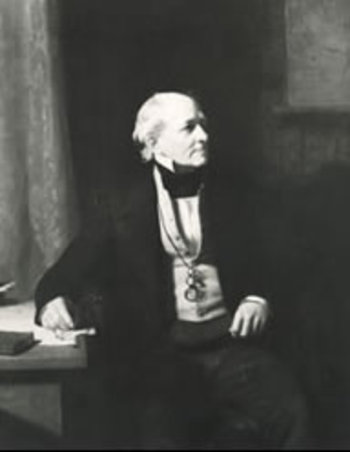JF Ptak Science Books Post 1784 [An Episode in the series The History of Blank, Empty and Missing Things.]
 207 years ago Admiral Sir Francis Beaufort proved that he could record a seemingly unrecordable medium. He was able to write on the air, basically, affixing a permanent and economical, understandable, common denominator to something that no one could actually “see” (but could see the effects of), and that everyone could feel and measure, but not capture. He created the Beaufort wind force scale, and it has been in use as a lingua franca (with some modifications) ever since--the wind force scale. It was a pretty important vocabulary (language, really) to establish, as there wasn’t any agreed upon terminology before his—a ‘stiff breeze” might mean one thing to a Mainer and another to someone in Santa Barbara, while a gentle breeze might mean something completely different to someone at Gibraltar than to someone else in the Kill Van Kull of Staten Island. Beaufort fixed this problem, and fixed it good.
207 years ago Admiral Sir Francis Beaufort proved that he could record a seemingly unrecordable medium. He was able to write on the air, basically, affixing a permanent and economical, understandable, common denominator to something that no one could actually “see” (but could see the effects of), and that everyone could feel and measure, but not capture. He created the Beaufort wind force scale, and it has been in use as a lingua franca (with some modifications) ever since--the wind force scale. It was a pretty important vocabulary (language, really) to establish, as there wasn’t any agreed upon terminology before his—a ‘stiff breeze” might mean one thing to a Mainer and another to someone in Santa Barbara, while a gentle breeze might mean something completely different to someone at Gibraltar than to someone else in the Kill Van Kull of Staten Island. Beaufort fixed this problem, and fixed it good.
Oddly enough, Beaufort’s system was introduced at about the same exact time as Luke Howard's system (of 1803 versus 1805) for organizing another very fluid, gigantic, series of extraordinarily common and global occurrences that had escaped scientific classification for thousands of years—the clouds. (I wrote about this a little earlier in this blog.) 
Classification systems for the wind have existed for a long time though they haven’t really been of a fundamental, descriptive value. For example, reaching back into the misty Greek mythological past we find the four winds were personified as gods, called the Anemoi, including Boreas, Notos, Euros, and Zephyros) Another area of creep and crawl for wind classifications and descriptions can be found (slightly) in the Bible--blowing from the four quarters of heaven, (Jer. 49:36; Ezek. 37:9; Dan. 8:8; Zech. 2:6); parching east wind (Ezek. 17:10; 19:12) and strong wind (Job 27:21), while the south wind was hot (Job 37:17, and so on, though they were all subject to the wants and needs of god (Ps. 18:10; 135:7), which is their greatest unifying factor (though of little use in descriptive transaction). The named components of wind (geostrophic wind, thermal wind (not actually a wind but a wind difference between two levels), gradient and ageostropic wind) are newer and valuable additions but of course cannot compare to the overall importance of the Beaufort contribution.
There are many other examples from many other cultures, the discussion of the wind and winds can take up a chunk of the anthropological/theological universe. A quicker,easier way to look at regional naming and classifying systems for the wind is to simply look at “individual” winds—winds that have certain characteristics, are particular to a location or time, and which also have a personality. There are some highly descriptive and mysterious names among them: for example, the Fremantle Doctor (afternoon sea breeze from the Indian Ocean which cools Perth, Western Australia during summer), and Squamish (strong, violent wind occurring in many of the fjords of British Columbia) Again, the overall power of applying descriptions of the Bayamo (violent wind on Cuba's southern coast) to the Bora (northeasterly from eastern Europe to northeastern Italy) to the Cape Doctor and the Passat are not terribly useful, especially if you were trying to communicate a wind system before you.
Beaufort supplied what was in effect Dalton’s table of the chemical elements (and the creation of the atomic theory, 1802), and did so, just as in the case with Luke Howard, incredibly, at about the same time: Dalton in 1802, Howard in 1803, and Beaufort in 1805. I'm just now appreciating the extraordinary organizing party that took place here over these four years: Dalton organizing (with great prediciive powers) the unseen atomic world and the world of the elements; Howard applying scientific means to naming the greatest of the scientifically-unnamed whales of science in the clouds; and Beaufort, who performed a Luke-like task with the wind just two years later. I'm not so sure that there was a better short period than this for naming anything in the history of science. Ever.
A good modern chart of the Beaufort scale can be found here.



Comments